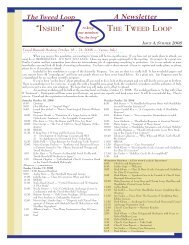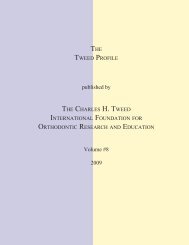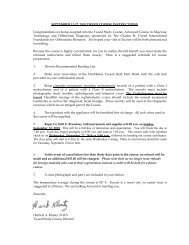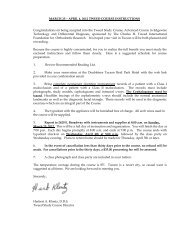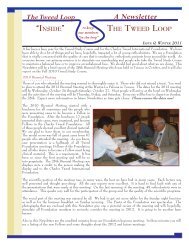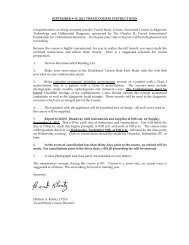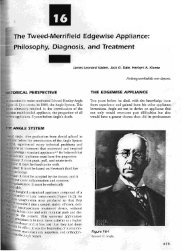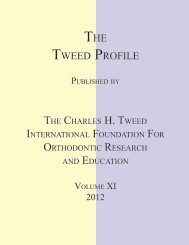the tweed profile - The Charles H. Tweed International Foundation
the tweed profile - The Charles H. Tweed International Foundation
the tweed profile - The Charles H. Tweed International Foundation
Create successful ePaper yourself
Turn your PDF publications into a flip-book with our unique Google optimized e-Paper software.
CHANGES IN ARCH WIDTH AFTER ORTHODONTIC<br />
TREATMENT: A LITERATURE REVIEW<br />
HYO EUN KIM<br />
DAEGU, KOREA<br />
It is a well established fact that increases in dental<br />
arch width during orthodontic treatment tend to return<br />
toward pretreatment values during and after retention.<br />
However, changes in arch width inevitably occur<br />
during and after orthodontic treatment as a result<br />
of growth or treatment. In this literature review <strong>the</strong><br />
historical background of maintenance of arch width is<br />
studied and some consequences of changing of arch<br />
width during treatment are also discussed.<br />
MAINTENANCE OF ARCH WIDTH DURING ORTHODONTIC<br />
TREATMENT<br />
In <strong>the</strong> middle 1920s, <strong>the</strong> apical base school formed<br />
around <strong>the</strong> writings of Axel Lundström who suggested<br />
that <strong>the</strong> apical base was one of <strong>the</strong> most important<br />
factors in <strong>the</strong> correction of malocclusion and<br />
maintenance of a correct occlusion. Nance noted that<br />
“if a stable result is to be attained, mandibular teeth<br />
must be positioned properly in relation to basal bone.”<br />
McCauley made <strong>the</strong> following statement, “since <strong>the</strong>se<br />
two mandibular dimensions, molar width and cuspid<br />
width, are of such an uncompromising nature, one<br />
might establish <strong>the</strong>m as fixed quantities and build <strong>the</strong><br />
arches around <strong>the</strong>m.” After measuring a large number<br />
of cases, including successes and failures, Strang drew<br />
certain conclusions and said, “Stable results can only<br />
be gained when <strong>the</strong> width of <strong>the</strong> mandibular denture in<br />
<strong>the</strong> canine and molar areas is maintained inviolate.”<br />
<strong>The</strong> ‘lateral limit’ is referred to as one of four<br />
basic premises defined by Merrifield’s ‘diagnostic<br />
concept of dimensions of <strong>the</strong> dentition’. Vaden said,<br />
“lateral expansion works if you believe in permanent<br />
retention.” and “<strong>the</strong> dentitions that exhibited <strong>the</strong> most<br />
relapse are, in most instances, <strong>the</strong> ones that have<br />
undergone <strong>the</strong> most mandibular canine expansion.”<br />
COMPARISONS OF THE ARCH WIDTH CHANGES BETWEEN<br />
EXTRACTION AND NON-EXTRACTION TREATMENT<br />
Motivated by a question that concerned <strong>the</strong><br />
possibilities of dental arch expansion and <strong>the</strong><br />
maintenance of such expansion, Walter investigated<br />
50 non-extraction cases and 50 extraction cases.<br />
Intercanine width and intermolar width were measured<br />
before treatment, following completion of active<br />
treatment, and at least one year following removal of<br />
retainers. In 31 or 62% of <strong>the</strong> non-extraction cases, an<br />
increase of 2.0 mm of intercanine width was obtained<br />
and maintained. And in <strong>the</strong> extraction cases 31 or<br />
62% showed an increase of 1.4 mm of intercanine<br />
width which was also obtained and maintained. In<br />
36 or 72% of <strong>the</strong> cases in <strong>the</strong> non-extraction group<br />
an average increase of 1.8 mm was obtained and<br />
maintained in intermolar widths. Conversely, in <strong>the</strong><br />
extraction sample intermolar widths, 35 or 70% of<br />
<strong>the</strong> cases demonstrated a contraction or decrease of<br />
2.9mm. Overall, <strong>the</strong> intercanine distances behaved<br />
<strong>the</strong> same in <strong>the</strong> non-extraction and extraction cases:<br />
<strong>the</strong> intermolar distances of <strong>the</strong> non-extraction cases<br />
tended to increase and those of <strong>the</strong> extraction cases to<br />
decrease.<br />
Bishara et al. evaluated treatment and posttreatment<br />
changes in <strong>the</strong> dental arches of patients with Class II,<br />
division 1 malocclusions. Half <strong>the</strong> patients (N=46)<br />
were treated with a non-extraction approach; treatment<br />
20



